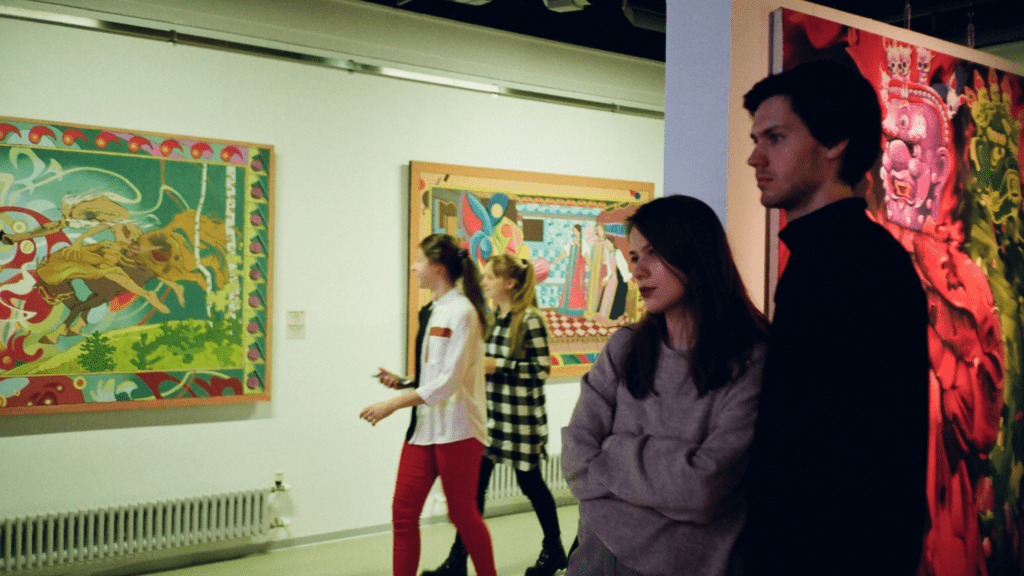Understanding the Art Exhibition Process
Knowing how art exhibitions work is essential to get your work noticed. Having a clear grasp of the process aids in making effective strategic moves.
Types of Art Exhibitions
Art exhibitions vary in type, each providing different opportunities:
- Commercial Galleries: These galleries sell art for profit. They select artists who match their brand.
- Non-profit Galleries: These focus on community and educational purposes. Their selection criteria may differ from commercial galleries.
- Juried Shows: A panel of judges selects the art. The competition level is usually high.
- Art Fairs: Artists pay for booth space to display and sell their work. This is ideal for direct sales.
- Museum Exhibitions: These are highly prestigious. Selections are often made by curators.
- Portfolio: A professional portfolio showcasing your best work is critical. Include high-quality images, artist statements, and a CV.
- Application Forms: Complete these accurately and provide all requested information.
- Entry Fees: Many exhibitions charge an entry fee. Ensure your budget accounts for this.
- Artist Statements: These explain your work and your artistic vision. Craft them thoughtfully.
- Meeting Deadlines: Submit your application and materials on time. Late entries usually aren’t accepted.
Developing a Strong Art Portfolio
An effective art portfolio serves as your visual resume, showcasing your best work and artistic vision. It should present both technical skills and creative ideas.
What to Include in Your Portfolio
Proper selection of artworks is crucial. Include:
- Diverse Pieces: Curate pieces showcasing different techniques and mediums. For instance, include paintings, sculptures, digital art, and installations.
- High-Quality Images: Use high-resolution images. Ensure each piece is clearly visible, with accurate colors.
- Recent Work: Focus on recent works from the last 2-3 years. This illustrates personal growth and current style.
- Artist Statement: Write a concise statement. It should explain themes, inspirations, and your artistic journey.
- Detailed Information: Provide titles, media used, dimensions, and year of creation for each piece.
Tips for Photographing Your Art
Presenting your work professionally requires quality photographs. Here’s how:
- Proper Lighting: Use natural, indirect light. Avoid harsh shadows or glares.
- Stable Camera Setup: Use a tripod for sharp images. Avoid hand-held blurs.
- Neutral Background: Choose a plain, non-distracting background. White or gray often works best.
- Consistent Angles: Photograph flat works head-on and three-dimensional pieces from multiple perspectives.
- Post-Editing: Correct color balances and crop photos to remove unnecessary edges.
A strong portfolio reflects your best potential and captures the essence of your artistic identity, critical for attracting galleries and exhibition opportunities.
Finding the Right Exhibitions
Identifying suitable exhibitions is crucial for showcasing art effectively. Focus on understanding the landscape and targeting opportunities that align with individual artistic styles and goals.
Researching Potential Venues
Evaluating exhibition spaces matters for having a successful show. Start by exploring local galleries, museums, and art fairs. Local art directories and online platforms also list upcoming shows.
Narrow down the options by considering the venue’s reputation and the types of art they showcase. Contact venue coordinators when specific questions arise about submission guidelines or exhibition criteria. Checking past exhibitions helps identify trends and artists represented in that space.
Leveraging Local Art Scenes
Getting involved in the local art community boosts visibility and creates networking opportunities. Attend community events, art walks, and gallery openings to meet other artists and curators.
Local art organizations often provide resources, workshops, and calls for submissions. Building relationships with local artists can lead to collaborations and shared exhibition opportunities. Volunteering at arts organizations shows commitment and helps in understanding the logistics behind exhibitions.
Crafting a Compelling Application
Creating a standout application increases the chances of getting your art into exhibitions. Places where first impressions matter include artist statements and exhibition proposals.
Writing an Artist Statement
An artist statement provides context and insight into your work. This brief, first-person text should describe your artistic vision, creative process, and themes.
- Vision: Explain the overarching message or concept behind your art. An example: “My art explores the intersection of nature and technology.”
- Creative Process: Detail your methods and techniques. For example, “I use mixed media, combining digital prints and watercolor, to achieve textured landscapes.”
- Themes: Identify recurring motifs, such as identity or environment. A statement might be, “My recent series focuses on the impact of urbanization on wildlife.”
Essential Elements of an Exhibition Proposal
An exhibition proposal should include key components that present a coherent narrative for your artwork.
- Project Description: Summarize the exhibit’s concept, highlighting its relevance. Include details like, “This exhibit examines urban landscapes through abstract painting.”
- Artwork List: Provide a list with titles, dimensions, mediums, and dates. For example:
| Title | Dimensions | Medium | Date |
|---|---|---|---|
| “Cityscape” | 24″x36″ | Oil on canvas | 2023 |
| “Metropolis” | 18″x24″ | Mixed media | 2022 |
- Exhibit Layout: Suggest an arrangement of your pieces within the space. Describe how artworks complement each other and guide viewers’ experience.
A well-crafted application showcases your professionalism and understanding of exhibition requirements. This approach to developing artist statements and proposals can effectively communicate your artistic narrative to curators.
Preparing for the Exhibition

Preparing for an exhibition involves meticulous planning. Effective packing, transporting, and promotional strategies ensure your artwork’s safety and visibility.
Packing and Transporting Art
Proper packaging prevents damage during transit, which is crucial for maintaining your art’s integrity. Use acid-free materials to wrap your artwork, and secure corners with foam protectors.
If transporting framed pieces, ensure the glass is protected with corner guards and a layer of bubble wrap. When shipping larger pieces, wooden crates offer extra protection. For additional security, label each package with ‘Fragile’ and ‘Handle with Care’ stickers.
Promotional Strategies for Artists
Effective promotion increases the visibility of your exhibition. Leverage social media platforms to share stories, behind-the-scenes content, and event details. Create a professional press release to distribute to local art blogs, magazines, and news outlets.
Email invitations to your mailing list and use art-focused platforms such as ArtRabbit or Artforum to announce your show. Collaborate with other artists to cross-promote and expand your audience reach.


